
- Brand Kershaw
- Color Black
- Blade Edge V-Grind

- Brand Kershaw
- Item Weight 68 Grams
- Blade Shape Drop Point

- Brand OUTDOOR EDGE
- Color Orange
- Blade Edge Plain

- Brand Old Timer
- Color Multi
- Blade Shape Clip Point
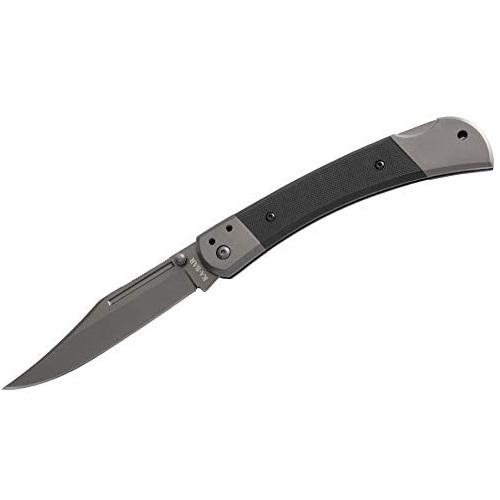
- Brand KA-BAR
- Color Black
- Blade Edge Hollow
Choose the Best Folding Hunting Knife
Customer’s Choice: the Best Rated Folding Hunting Knives
0 users answered this survey. Please help us improve this review!
Are you in the market for a new folding hunting knife? If so, you’re in luck! In this blog post, we will be discussing the top 5 folding hunting knives that are available for purchase. We’ll be going over the pros and cons of each knife, as well as what sets them apart from the competition. So, whether you’re a seasoned hunter or just getting started, read on to find the perfect folding hunting knife for you!
Table of Contents
Kershaw Brawler Lockable Steel Folding Pocket Knife
 Do you want to purchase a multipurpose hunting knife that will serve as both a knife and an ax? The Kershaw Brawler is perfect for those who want a reliable blade that won’t break the bank. Made with durable steel construction, this knife can take on anything you throw at it.
Do you want to purchase a multipurpose hunting knife that will serve as both a knife and an ax? The Kershaw Brawler is perfect for those who want a reliable blade that won’t break the bank. Made with durable steel construction, this knife can take on anything you throw at it.
Plus, the reversible and locking blade is perfect for those who like to be able to switch between tasks quickly and easily. And with a comfortable and stylish glass-reinforced nylon handle, this knife will make it easy to take your Hunting game to the next level. However, some reviewers informed us about several drawbacks. The blade locking mechanism is loose, meaning that the blade could easily close on your fingers while you’re using it. Additionally, the “black oxide” coating comes right off with just a few uses, exposing the cheap steel underneath. So, while this knife is good for its price, be aware of its limitations before making your purchase.
Kershaw Adjustable Clash Pocket Knife with Stainless Steel Blade
 Do you want a pocket knife that can be used for many things? Check out the Kershaw Clash Pocket Knife! This superb quality knife features a reversible, locking blade that is adjustable and has a black-oxide finish. The knife includes a serrated blade and a pocket clip for convenient carrying.
Do you want a pocket knife that can be used for many things? Check out the Kershaw Clash Pocket Knife! This superb quality knife features a reversible, locking blade that is adjustable and has a black-oxide finish. The knife includes a serrated blade and a pocket clip for convenient carrying.
Plus, the blade lasts longer thanks to the superior quality construction. However, please use caution when adjusting the blade as it can create a safety hazard if not done correctly. Also, avoid bending the blade as this might snap the tip. But overall, this is an excellent knife for anyone looking for a versatile and durable option!
Lightweight Outdoor Edge Folding Knife (6 Blades)
 This is the knife for those who like to be prepared for anything. The Lightweight Outdoor Edge Folding Knife has six blades made of stainless steel, meaning it’s razor-sharp and will never rust. It’s also incredibly lightweight and comes with a pocket clip for easy carrying.
This is the knife for those who like to be prepared for anything. The Lightweight Outdoor Edge Folding Knife has six blades made of stainless steel, meaning it’s razor-sharp and will never rust. It’s also incredibly lightweight and comes with a pocket clip for easy carrying.
Plus, the blade is replaceable, so you’ll never have to worry about it losing its edge. The high profile is uncomfortable to carry and the blade is fragile, but it’s still a great choice for casual outdoor use. And at 3.5 inches, it’s the perfect size for any adventure. But don’t take our word for it – try it out for yourself and see.
Old Timer Folding Lockback Hunting Knife with Belt Sheath
 Are you looking for a lightweight, yet durable outdoor folding knife? The Outdoor Edge Folding Knife is an excellent addition to any outdoor excursion! This knife is perfect for those who need quick and easy access to a blade, as it can be easily opened with one hand.
Are you looking for a lightweight, yet durable outdoor folding knife? The Outdoor Edge Folding Knife is an excellent addition to any outdoor excursion! This knife is perfect for those who need quick and easy access to a blade, as it can be easily opened with one hand.
The high carbon stainless steel construction ensures that the knife will withstand even the most strenuous use, while the multicolor handle prevents slipping, even in wet conditions. Plus, the stiff action and rough locking mechanism make this knife perfect for self-defense applications. So whether you’re an outdoorsman who needs a trusty knife for your next camping trip or someone who wants a reliable option for self-protection, the Outdoor Edge Folding Knife is the perfect choice for you!
KA-BAR Stainless Steel Black Fiberglass Handle Deer Hunter
 The KA-BAR Stainless Steel Black Deer Hunter is the perfect knife for those who want a Dependable Blade. With a black, stainless steel blade that is durable and solid, this knife can take on any slicing, hunting, or skinning task you put it to.
The KA-BAR Stainless Steel Black Deer Hunter is the perfect knife for those who want a Dependable Blade. With a black, stainless steel blade that is durable and solid, this knife can take on any slicing, hunting, or skinning task you put it to.
The reversibility of the blade makes it ideal for lefties, and the belt clip will not get in the way. The blade is manufactured to endure corrosion and wear, making it perfect for outdoor use. The ergonomics of the knife make it comfortable to grip and easy to control. However, be aware that it can dull quickly so take care of your knife properly to avoid this.
Now that you know a little bit more about folding hunting knives, it’s time to choose the perfect one for you. It might be difficult to choose the correct one for you when so many excellent alternatives are available. But with our buyer’s guide, you’ll be able to discover the ideal knife for your needs in no time. So what are you waiting for? Get out there and start shopping! And don’t forget – when in doubt, always go with trusted brands we mentioned above. You can’t go wrong with quality.Happy hunting!
To find the best folding hunting knives, we looked at a variety of factors. First, we considered the type of blade. For example, some knives have a drop-point blade, while others have a clip-point blade. Drop-point blades are great for gutting and skinning games, while clip-point blades are better for precision tasks like carving.
Next, we looked at the handle material. Some handles are made from wood or bone, while others are made from synthetic materials like G-1000 Composite. We also considered the size and weight of the knife. Heavier knives are great for chopping and slicing tasks, but they can be cumbersome to carry on long hunts. Lighter knives are easier to carry but may not be as durable.
Finally, we looked at the price. Hunting knives can range in price from $25 to $200. We considered both budget-friendly and premium options to find the best value for your money.
Buyer’s Guide
If you’re in the market for a new folding hunting knife, there are a few things you’ll want to keep in mind. In this buyer’s guide, we’ll touch on some important factors to consider before making your purchase.
First and foremost, you’ll want to make sure that the knife you choose is made from high-quality materials. The last thing you want is for your knife to break or fail when you need it most. You should also make sure that the blade is sharp and can hold an edge well.
Another important factor to consider is the size of the knife.
If you plan on using your knife for hunting, you’ll want to make sure that it’s big enough to skin and dress game.Finally, you should also consider the price of the knife. While you don’t want to skimp on quality, you also don’t want to spend more than you need to.
About Folding Hunting Knives
Folding hunting knives are an essential tool for any serious hunter. They can be used for a variety of tasks, including skinning and cleaning games, preparing food, and even self-defense in a pinch. A good folding hunting knife should be strong, durable, and easy to carry. It should also have a sharp blade that can handle any task you throw at it. [1]
How Do You Intend to Use Your Hunting Knife?
The first question you need to answer is how do you intend to use your knife? If you plan on using it for the skinning game, then you’ll want a knife with a gut hook. This will make the job much easier and quicker.
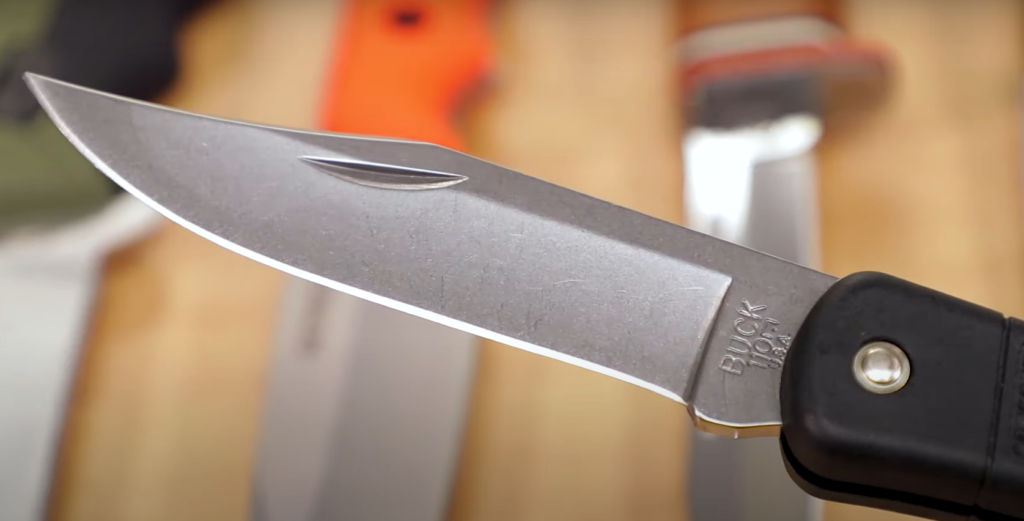
If you just plan on using it for general camp chores like cutting a cord or slicing cheese, then any good quality folder will suffice. Just make sure that the blade is made of stainless steel so it won’t rust. [2]
What’s Your Budget?
The next thing to consider is your budget. How much are you willing to spend on a hunting knife? You can find decent quality knives for under $50 but if you want something really top-of-the-line, you’re going to have to spend closer to $200.
Benefits of a Folding Knife
A folding knife is a type of knife with a blade that folds into the handle. Folding knives are usually smaller than fixed-blade knives, making them more portable and easier to carry. They’re also safer to use because the blade is less likely to accidentally close on your fingers.
Folding knives are ideal for hunters because they can be easily carried in a pocket or pack, and they’re less likely to get damaged when you’re out in the field. Moreover, folding knives are less likely to scare away the game, which is an important consideration for ethical hunters.
Another critical benefit of a folding knife is that it can be easily opened with one hand, which can be a lifesaver if you’re injured and need to cut yourself free from something. [3]
5 Key Reasons to Pick Up a Folding Hunting Knife
Folding hunting knives are an essential tool for any outdoorsman or hunter. They provide a great deal of utility and can be used for everything from skinning games to preparing food. Here are five reasons why you should consider picking up a folding hunting knife:
- Folding hunting knives are much easier to carry than fixed-blade knives. This is because they can be easily stored in your pocket or backpack.
- They offer a lot of utility. Folding hunting knives can be used for tasks such as gutting fish, skinning games, and preparing food.
- They are very versatile. Folding hunting knives can be used for both general-purpose tasks and more specific ones such as carving wood or cleaning small game.
- They are relatively inexpensive. When compared to fixed-blade knives, folding hunting knives are very affordable.
- They are easy to sharpen. Folding hunting knives can be easily sharpened with a honing stone or diamond sharpener. This makes them great for those who do not have a lot of experience with knife maintenance. [4]
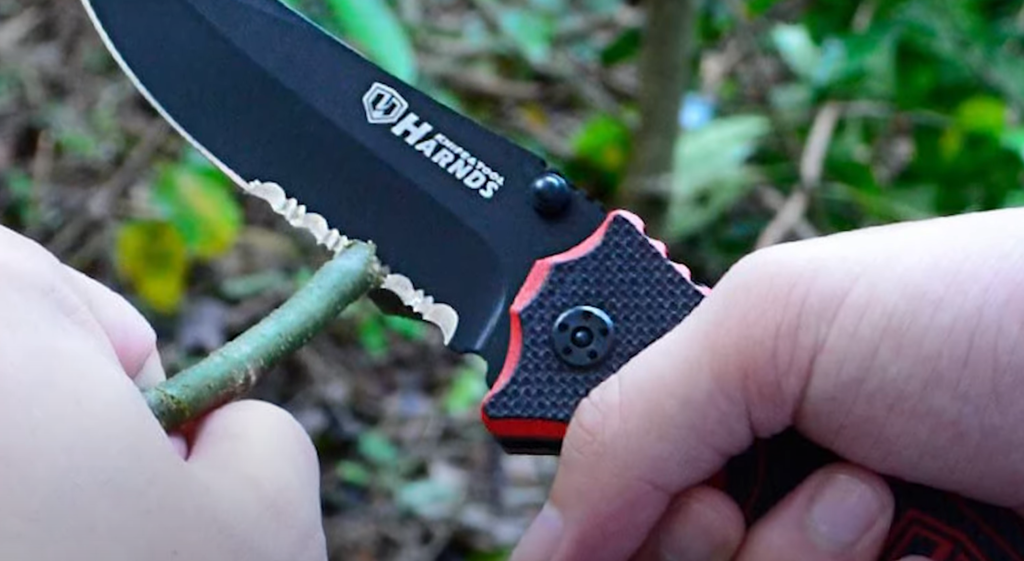
If you are looking for a new knife to add to your collection, then be sure to check out our list of the top five folding hunting knives to buy. We have included a variety of different knives so that you can find the perfect one for your needs. Happy hunting!
What’s Essential to You in Folding Hunting Knives?
PRICE
First and foremost, you should always consider your budget when choosing any type of knife. With that said, a good-quality folding hunting knife doesn’t have to be expensive. In fact, there are plenty of great options available at an affordable price point.
BLADE LENGTH
The next thing you’ll want to think about is the blade length. For hunters, a longer blade is usually better because it can tackle tougher tasks like skinning and gutting game. However, a longer blade will also be more difficult to carry around. So, it’s really a matter of finding the right balance for your needs. [5]
MATERIALS
When it comes to the materials used in construction, you’ll want to choose something that’s durable and can stand up to the elements. Stainless steel is a good option, as it’s resistant to corrosion and won’t rust. [6]
OPENING STYLE
There are two main types of opening styles for folding knives: manual and automatic. Manual knives require you to use your thumb to open the blade, while automatic knives have a button that releases the blade.
TYPES OF BLADES
There are three main types of blades used on folding knives: clip point, drop point and skinning. Each type has its own advantages and disadvantages.
CLIP POINT: A clip point has a straight or concave back edge and a spine that curves toward the tip. This type of blade is good for precision cuts and slicing.
DROP POINT: A drop point has a convex back edge and a spine that slopes toward the tip. This type of blade is ideal for light-duty work and can perform precision cuts as well as big-work tasks.
SKINNING: A skinning knife has a curved blade with a sharp point. This type of blade is designed specifically for skinning game animals. [7]
There are also other blade shapes that are designed for specific tasks such as gutting, fileting, and boning.
Which type of blade is best for you will depend on what type of hunting you do and what tasks you need to perform while out in the field.
In general, a good all-purpose knife should have a drop point or skinning blade. These types of blades can handle most tasks that you will come across while hunting.
If you hunt primarily big game, then a skinning knife is going to be your best bet. If you do a lot of small game hunting or trapping, then a clip point or drop point knife will work well.
GUT HOOK: A gut hook is a specialized knife for cutting through the intestines of animals. This type of blade has a hook on the end that is used to open up the animal’s abdomen.
FILET KNIFE: A filet knife is a special-purpose fish fileting blade. This type of blade is very thin and flexible, which allows it to easily remove the meat from the fish bones.
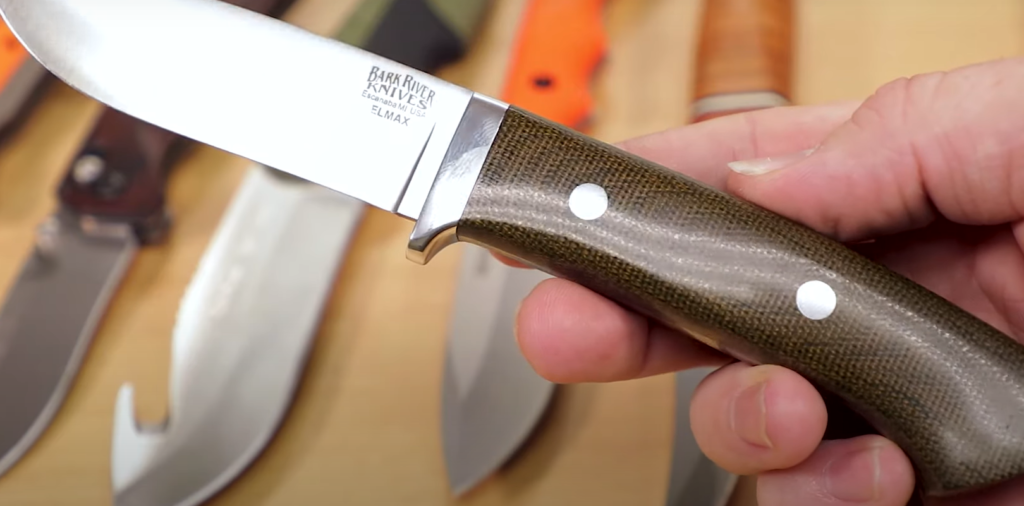
BONING KNIFE: A boning knife is a specific sort of knife that’s made to remove meat from bones. A boning knife with a thin, sharp point that can pierce between joints and muscles to extract the meat without damaging the bone is of this type. [8]
ERGONOMICS
The first thing you want to consider when purchasing a folding hunting knife is ergonomics. You want a knife that feels good in your hand and provides a comfortable grip. There are many different handle materials and designs on the market, so it’s important to find one that suits your needs.
SERRATIONS VS. PLAIN EDGE
When it comes to choosing a blade for your folding hunting knife, there are two main types of edges to consider: serrated and plain. It’s easier to recognize the benefits and drawbacks of each technique before choosing a method.
However, they can be more difficult to sharpen than plain blades. Additionally, serrations can sometimes snag on clothing or skin.Plain blades, on the other hand, are much easier to sharpen and usually provide a cleaner cut. However, they may not be as effective at cutting through tougher materials.
Ultimately, the best type of blade for you will depend on your personal preferences and what you plan to use your knife for. If you’re not sure, it’s always a good idea to carry both types of blades with you so that you’re prepared for anything.
LOCK TYPE
One of the first things you’ll want to consider when purchasing a folding hunting knife is the lock type.
Liner locks are the most popular type of lock found on folding knives. They’re also very strong and secure, making them ideal for hunting knives.
Frame locks are similar to liner locks, but they have a stronger locking mechanism. This makes them ideal for heavier-duty tasks like skinning or gutting games.
Button locks are less common than the other two types, but they’re still a good option for a folding hunting knife. Button locks are easy to operate with one hand and can be quickly released if necessary. [9]
BLADE MATERIAL
The next thing to consider is the blade material. The two most common materials are stainless steel and carbon steel.
Stainless steel is more resistant to rust and corrosion than carbon steel. It’s also easier to sharpen, making it a good choice for hunters who don’t want to spend a lot of time maintaining their knives.
Carbon steel is harder than stainless steel, so it holds its edge longer. However, it’s also more susceptible to rust and corrosion. If you choose a carbon steel knife, be sure to keep it well-oiled and clean after each use.
HANDLE MATERIALS
There are a few different types of materials that can be used for handles on folding knives including wood, metal, and synthetic (plastic/rubber). Before you buy, it’s a good idea to know what each type offers.
- Wood: Wooden handles have a classic look and feel, but they require more maintenance than other types of handle materials. Wood is also not as durable as some of the other options, so it’s important to take care when using a knife with a wooden handle.
- Metal: Metal handles are very strong and durable, but they can be slippery if your hands get sweaty. They’re also susceptible to rusting if they’re not properly cared for.
- Synthetic: Synthetic handles are made from materials like plastic or rubber. They’re usually more comfortable to hold than metal or wood, and they’re also very durable.
Folding Blade vs Fixed Blade
It is important to know the difference between a folding blade knife and a fixed blade knife, as each has its own advantages and disadvantages. A folding blade knife is more convenient to carry because it can be folded up and stored in a sheath, whereas a fixed blade knife must be carried in a belt or boot scabbard. Folding blades are also generally lighter and thinner than fixed blades, making them ideal for slicing tasks. However, fixed blades are stronger and can handle more abuse than folding blades. They are also less likely to get caught on something and snap shut on your fingers.
So, which type of hunting knife should you buy? It really depends on your needs and preferences.
How to Maintain Your Folding Knife
Folding knives need to be oiled periodically to prevent rust and corrosion. You should also clean the blades after each use, as dirt and debris can build up on the blade and cause it to dull prematurely. It is also a good idea to inspect the knife regularly for any damage or wear.
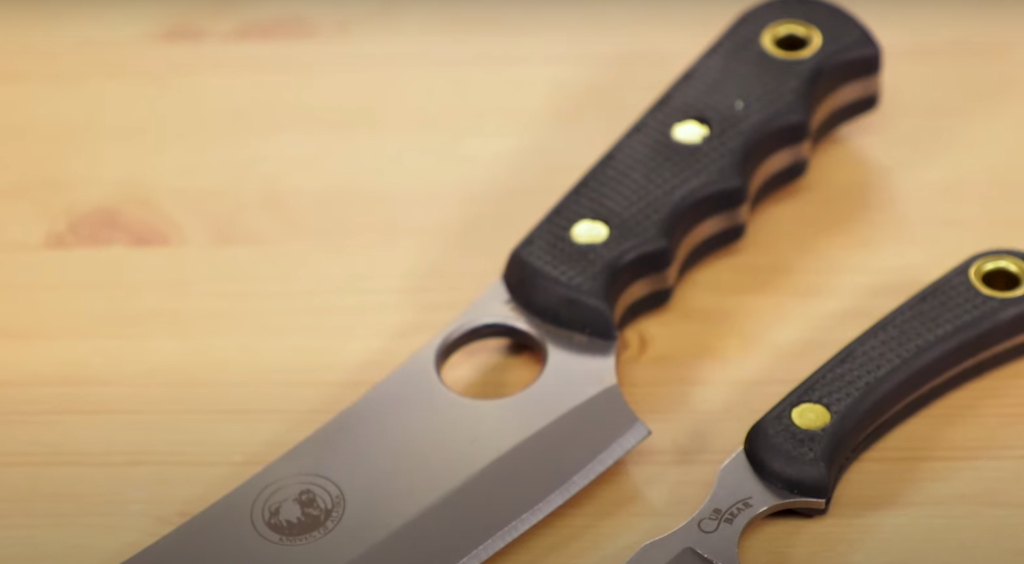
If you take care of your folding knife, it will last for many years. Here are some tips on how to maintain your knife:
- Wipe the blade down with a clean cloth after each use.
- Oil the blade and hinge monthly with a light lubricant, such as WD-40.
- Never store your knife in a sheath for more than a few days at a time, as this can cause the blade to rust.
- If your knife gets wet, dry it off immediately and oil it to prevent rusting.
- Never put your knife away dirty or wet.
- Inspect the blade regularly for chips, cracks, or other damage.
With proper care, your folding hunting knife will last for many years. By following these simple tips, you can ensure that your knife will be there when you need it most.
Sharpening Your Hunting Knife
If you’ve already got a great hunting knife, congratulations! You’re ahead of the game. But even the best knives need to be sharpened from time to time. A dull hunting knife is not only useless – it can actually be dangerous. So how do you go about sharpening your hunting knife?
There are a few different ways to sharpen a hunting knife, but we recommend using a sharpening stone. Start by wetting the stone with water (or oil, if you’re using a diamond stone). Then, hold the blade at a 20-degree angle and use long, even strokes to sharpen the blade. Remember to always stroke in the same direction – never back and forth.
Once you’ve finished sharpening, rinse off the knife and stone with water and dry them both off. And that’s it! With a little bit of care, your hunting knife will stay sharp for years to come.
Is It Legal to Possess a Hunting Knife?
In the United States, there is no federal law that prohibits the ownership of a hunting knife. However, some states have laws that restrict the carrying of knives in public places. It is always best to check with your local law enforcement agency to find out if there are any restrictions in your area.
The type of knife you purchase will also be determined by the game you plan on hunting. For example, a skinning knife would be suitable for a smaller game, while a gut hook knife would be better suited for a larger game such as deer or elk. [11]
FAQ
What is the optimum size for a hunting knife?
The optimum size for a hunting knife is between six and eight inches. Anything larger can be cumbersome, and anything smaller may not have the necessary cutting power.
What are the different types of steel used in hunting knives?
There are four types of steel commonly used in hunting knives: stainless steel, carbon steel, tool steel, and Damascus steel. Stainless steel is the most common type used because it is resistant to rust and corrosion. Carbon steel is often used for its strength and durability. Tool steel is known for its ability to retain a sharp edge. Damascus steel is prized for its aesthetic value.
What kind of blade grind should I look for in a hunting knife?
A blade grind is the shape of the blade’s cross-section. The most common grinds for hunting knives are flat, hollow, and saber.
Flat grinds are easy to sharpen and resist chipping, making them a good choice for use on tough materials like wood or bone. Hollow grinds are very sharp but can be difficult to resharpen; they’re best used on soft materials like game meat. Saber grinds offer a balance of sharpness and durability, making them a good all-purpose option.
The type of blade grind you choose should be based on what you’ll be using your knife for most often. If you’re not sure, a saber grind is a good middle-of-the-road option that will be versatile enough for most tasks.
What is the best handle material for a hunting knife?
The most common handle materials for hunting knives are wood, bone, and polymer (plastic).
Wood handles are classic and stylish but can be susceptible to rot and splitting if they’re not properly cared for. Bone handles are very durable but can become slippery when wet. Polymer handles are lightweight and low-maintenance, but may not be as comfortable to hold for extended periods of time.
The best handle material for you is one that strikes a balance between durability, comfort, and style. If you’re not sure which to choose, the polymer is a good all-around option that will suit most needs.
What kind of knife is best for gutting a deer?
A folding hunting knife is ideal for gutting a deer because it can be easily carried and stored. When choosing a folding hunting knife, consider the size, weight, and blade material.
The best folding hunting knives will have a comfortable handle that is easy to grip, and a sharp blade that can handle tough tasks. If you are looking for the perfect gift for the hunter in your life, check out our top five picks for the best folding hunting knives to buy.
Is Damascus steel a viable option?
If you’re looking for a top-quality folding hunting knife, Damascus steel is definitely a material you should consider. knives made with Damascus steel are known for their exceptional strength, durability, and sharpness. However, they can be quite expensive. If you’re on a budget, there are plenty of other great options available.
What knives do hunting guides employ?
When it comes to choosing a knife for hunting, there are many factors to consider. However, one of the most important is what type of knife do hunting guides use? After all, they’re the experts. Many guides prefer a fixed-blade knife because it can be more reliable and durable in the field. However, others prefer a folding knife because it’s more convenient to carry. Ultimately, it’s up to you to decide which type of knife is right for you.
What is the world’s largest hunting knife manufacturer?
Buck Knives is one of the most well-known and respected knife manufacturers in the world. They’ve been making knives for over a hundred years, and their experience shows in the quality of their products. If you’re looking for a top-notch hunting knife, Buck is definitely a brand you should consider.
What are some other great folding hunting knives?
In addition to Buck knives, there are many other great options available on the market. For example, Kershaw makes some excellent knives that are perfect for hunting. If you’re looking for something a little different, Cold Steel also makes some great hunting knives. In the end, it is your choice to determine which knife is best for you.
How to care for a folding knife?
Folding knives are easy to care for. Simply wipe the blade with a clean cloth after each use and oil it regularly. Be sure to keep the pivot point and lock mechanism clean and lubricated. Never put your knife away dirty or wet.
How often should you sharpen a folding knife?
It depends on how often you use it. A good rule of thumb is to sharpen your knife after every few uses. If you use it daily, then sharpening once a week should suffice.
What is the best way to store a folding knife?
The best way to store a folding knife is in a dry, cool place. A kitchen drawer or cabinet is a good option. You can also buy a knife block for safe storage.
Is it possible to use a folding knife in combat?
Folding knives have been used as weapons in many different cultures throughout history. In the modern world, they are still used by military and law enforcement personnel as well as by civilians for self-defense. While there are some folding knives that are designed specifically for combat, most can be used for both utility and self-defense purposes.
When choosing a folding knife for combat, it is important to consider the following factors: blade size and shape, handle material and design, locking mechanism, and deployability. The best combat knives will have a strong blade with a sharp point that can be easily deployed quickly. The handle should be comfortable to hold and provide a good grip, even when wet or covered in blood. And finally, the locking mechanism should be sturdy and reliable to prevent the blade from closing during use.
Useful Video: Top 10 Best Hunting Knives
Conclusion
So, there you have it – the top five folding hunting knives to buy. With so many great options on the market, it can be tough to choose just one. However, we hope that this buyer’s guide has helped you narrow down your search and find the perfect knife for your needs.
Thanks for reading and happy hunting!
Did you like this post? Subscribe to our newsletter for more great content like this, delivered straight to your inbox. Or follow us on social media for the latest news and updates from the hunting world.
We’d love to hear from you – leave a comment below and let us know which knife is your favorite. Happy hunting!
References:
- https://manofmany.com/lifestyle/uses-for-a-pocket-knife-that-will-change-your-life
- https://1source.basspro.com/news-tips/hunting-gear/4754/hunting-knife-buyers-guide-what-you-need-know
- https://www.knifecountryusa.com/shop/article/378/benefits-of-carrying-a-pocket-knife.html
- https://heinnie.com/blog/hunting-knives-guide/
- https://edc.ninja/gear/knives/pocket-knife-rules-laws-in-the-us/
- https://www.reliance-foundry.com/blog/304-vs-316-stainless-steel
- https://www.gearpatrol.com/outdoors/a476053/knife-blade-shapes-guide/
- https://www.russums-shop.co.uk/news/knives/q/date/2016/06/09/boning-knife-guide
- https://knifeinformer.com/pocket-knife-lock-types/
- https://summitknifeco.com/blog/fixed-blade-vs-folding-blade-edc-knives/
- https://edc.ninja/gear/knives/pocket-knife-rules-laws-in-the-us/






Leave a Reply